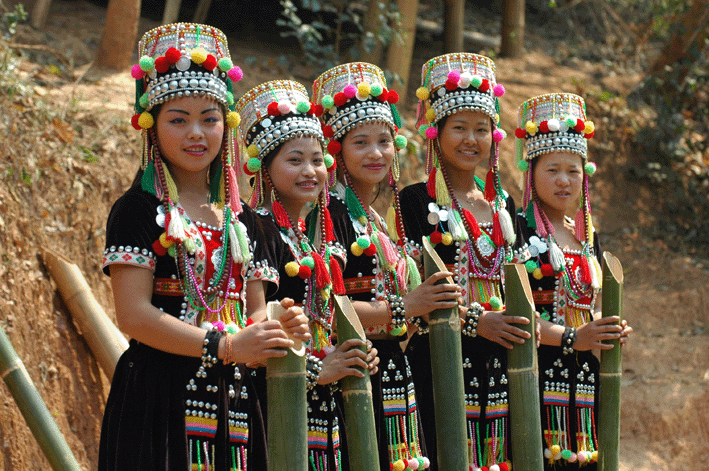

Hani Ethnic Minority


Most of the 1,253,952 (by 1999) Hanis live in the valleys between the Ailao and Mengle mountains in southern Yunnan Province. They are under the jurisdiction of the Honghe Hani-Yi Autonomous Prefecture.
Their language belongs to the Yi branch of the Tibeto-Burman Austronesian of the Chinese-Tibetan Phylum, and it can be subdivided into "Hani", "Bika" and "Suobai". Having no script of their own before 1949, they kept records by carving notches on sticks. In 1957 the central government helped them to create a script based on the Latin alphabet.
The Hani ethnic minority shares the same origin with the Yi and Lahu ethnic minorities. According to historical records, they all evolved from the ancient Qiang people. The Qiang people used to be a nomadic tribe living in the Qinghai-Tibetan Plateau. Later one branch of them moved south and early by the 3rd century, their forefathers had inhabited the swampland along the Dadu River and Yalong River. In the 7th century, they immigrated into the area near Mt. Ailao and Mt. Wuliang. In the Tang and Song dynasties, this area was successively reined in by the Nanzhao and Dali kingdoms. The Yuan Dynasty (1271-1368) established a prefecture to rule the Hani and other ethnic groups in Yunnan. The Ming Dynasty (1368-1644) exercised its rule through local chieftains, who were granted official posts. During the Qing Dynasty (1644-1911) court officials replaced the chieftains.
The Hani ethnic group comprises over twenty subgroups. They used to be called Hani, Aini, Kaduo, Biyue, Heni, etc. With the founding of the PRC in 1949, following consultation with the ethnic group, it was decided to agree upon the official name of Hani ethnic minority.
The Hanis are engaged in agriculture and build their two- and three- storey houses of bamboo, mud, stone and wood on hill slopes. The areas inhabited by the Hanis have rich natural resources. Being subtropical, the land is fertile and the rainfall plentiful -- ideal for growing rice, millet, cotton, peanuts, indigo and tea. Growing on the rolling Ailao Mountains are pine, cypress, palm, tung oil and camphor trees, and the forests abound in animals such as tigers, leopards, bears, monkeys, peacocks, parrots and pheasants.
They are polytheists and ancestor worshippers. Rituals are regularly held to worship the Gods of Heaven, Earth, the Dragon Tree and their village, as well as their family patron gods.
The Hani people celebrate their New Year in October, as their lunar calendar begins in that month. They also celebrate the June Festival, which falls on the 24th of that month. This is a happy occasion especially for the young people. They sing, dance, play on swings and hold wrestling contests. At night, people in some places light pine torches while beating drums and gongs to expel evil spirits and disease. Like their Han neighbors, the Hanis also celebrate the Spring Festival, the Dragon Boat Festival and the Mid-autumn Festival.
According to the Hani people's custom, a son's name begins with the last one or two words of his father's name in order to keep the family line going.
You will only receive emails that you permitted upon submission and your email address will never be shared with any third parties without your express permission.
